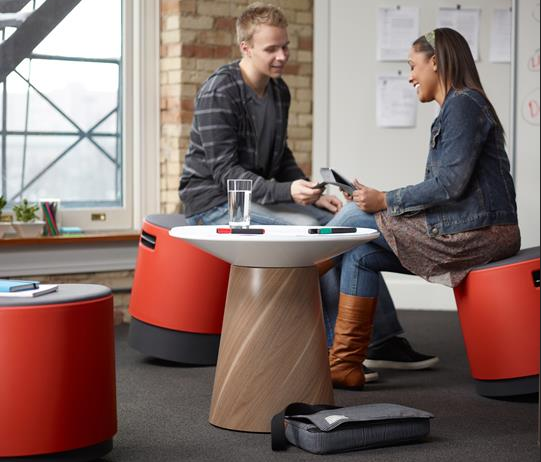Each new year, I try one or more things to enhance my personal productivity. I report here on a new seat and a 7″ tablet, potential productivity boosters. And also my productivity debacle courtesy of Yahoo Mail.
Sitting Healthily. We can take a short- or long-term view of personal productivity. In the long-term, we need to think about ergonomics and our personal health. I have read numerous reports in the last couple of years about how sitting all day is very unhealthy, even for those who exercise regularly. I have made a conscious effort to stand more often, especially on phone calls where I do not need to see my computer screen or take notes. Will this work? Who knows but I see no downside.
While I’m not sure that the type of seat actually matters, I have from time to time looked at “wobbly chairs”. I have not been willing to spend a lot on one because I don’t know if I will like it. So I was excited in December to to read about the Turnstone Buoy seat. Turnstone is owned by Steelcase, a leading provider of office furniture. I have, in the last two days, been using this:
So far, I like it (the picture shows the exact color combination I bought – many others available). I can feel that I need to use my body to keep it stable as I type; plus, it’s easy to fidget / move around on it, unlike in a regular chair. With the price a bit north of $200 (with shipping), it’s a good low, cost experiment.
Tablets: 7″ vs. 10″ and Android vs. iOS. On Cyber Monday, Amazon had a special on the Kindle Fire HDX 7″ tablet. I had been thinking that I should try out the seven-inch tablet form factor and learn about Android (I have had an iPhone and iPad for quite some time but this is my first non iOS mobile device).
I’ve only used my Kindle for about six weeks and the jury is still out. I like that I can hold it in one hand and found it was easier to read on it than my iPad when I took Metro (DC subway). Because it is lighter weight and much less expensive than my iPad, I am more willing to bring it to the gym and use it on an exercise machine. It works well in that environment though I find a 10″ tablet easier to read while bouncing around on an elliptical trainer.
I will, for a time, carry both my Kindle and iPad on trips. That’s a lot of digital equipment to lug in addition to my Ultrabook. But improving personal productivity does require some investment. Whatever my field testing finds, I am glad to have exposure to Android, even if it is the heavily modified Amazon version of it. So far, I find it harder to use than iOS but that may just be lack of experience.
When the Cloud Goes Bad: Yahoo! Mail Failure. Not all personal productivity news is good. On December 23, 2013, I found that my Yahoo! Mail account was failing. I would delete or move messages in the web interface but they were not deleted – a refresh showed them still in the inbox. Moves and deletes were also failing on my iOS devices. Filters I had to move incoming messages to folders were failing some of the time.
I reported the problem to Yahoo! customer service and did receive prompt replies. The problem, however, continued over two weeks and customer service stopped sending me updates. It appears fixed now but I have lost confidence in Yahoo.
This experience also gives me pause about cloud services generally. What do we do when core cloud services we use fail – or go away. The answer is easy: we struggle. I had to change how I use email for a time to compensate for Yahoo failures. When Google discontinued its feed reader mid-2013, I had to switch to Feedly. When Google alerts essentially stopped working, I had to find another service. So my Yahoo! Mail experience is a reminder that when we depend on the cloud, it’s best to have some redundancy in how you work. Fortunately, I mainly use my Yahoo email for alerts and I have other accounts. But I’m not sure what someone would do who had only Yahoo.
Archives
Blog Categories
- Alternative Legal Provider (44)
- Artificial Intelligence (AI) (57)
- Bar Regulation (13)
- Best Practices (39)
- Big Data and Data Science (14)
- Blockchain (10)
- Bloomberg Biz of Law Summit – Live (6)
- Business Intelligence (21)
- Contract Management (21)
- Cool Legal Conferences (13)
- COVID-19 (11)
- Design (5)
- Do Less Law (40)
- eDiscovery and Litigation Support (165)
- Experience Management (12)
- Extranets (11)
- General (194)
- Innovation and Change Management (188)
- Interesting Technology (105)
- Knowledge Management (229)
- Law Department Management (20)
- Law Departments / Client Service (120)
- Law Factory v. Bet the Farm (30)
- Law Firm Service Delivery (128)
- Law Firm Staffing (27)
- Law Libraries (6)
- Legal market survey featured (6)
- Legal Process Improvement (27)
- Legal Project Management (26)
- Legal Secretaries – Their Future (17)
- Legal Tech Start-Ups (18)
- Litigation Finance (5)
- Low Cost Law Firm Centers (22)
- Management and Technology (179)
- Notices re this Blog (10)
- Online Legal Services (64)
- Outsourcing (141)
- Personal Productivity (40)
- Roundup (58)
- Structure of Legal Business (2)
- Supplier News (13)
- Visual Intelligence (14)

